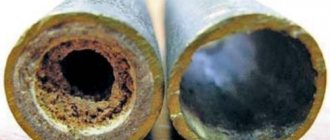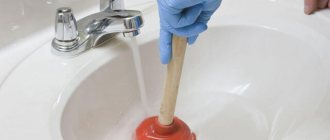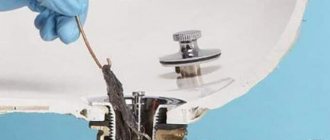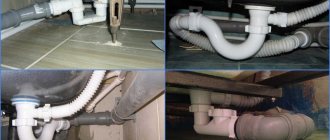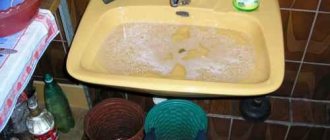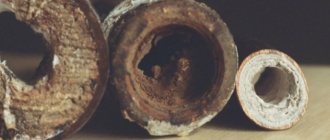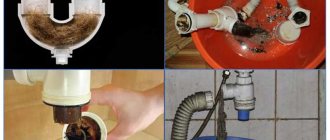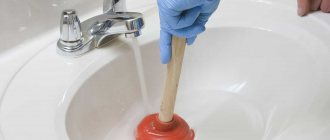When the water doesn’t come out of the toilet or bathtub, it’s not a big deal. But if it not only does not leave, but also arrives, and not at all clean, this is already a serious problem. And a foul-smelling symptom indicates only one thing: the sewer riser is clogged. Most often, the problem arises due to the fault of the neighbors living above, who flushed something very large down the toilet, and clearly not intended to be flushed down the drain. If there is only a roof on top, the reason may be that a small animal, a bird's nest, or garbage has gotten into the riser, which someone, for unknown reasons, decided to throw into the sewer vent.
In our article you will learn how to clean a sewer riser, how to clear the blockage yourself without calling specialists, and what you will need for this.
Where did the blockage occur?
To choose the right sewer cleaning method, you need to understand where the blockage has formed. To do this, drain the water one by one at all points. If the water does not go somewhere in one place, the siphon is most likely clogged. The second reason is a blockage in the section of the pipe before connecting to the main sewer.
Consequences of a clogged sewer in an apartment
If the water does not leave at all, and even overflows from one device to another (you open the water in the sink, it appears in the bathroom or the level in the toilet begins to rise), the common sewer outlet is clogged.
If we are talking about a private house, this is a branch to a septic tank or cesspool; if we are talking about an apartment, this is the section to the riser or even the sewer riser itself. In the case of a clogged riser in an apartment, there can be an unpleasant situation - when water is drained from the upper floors, due to a blockage in the sewer, it flows into yours and rises in the bathroom or toilet. If the situation is like this, call the plumbers - you can’t handle it on your own, you need powerful equipment.
If the sewage system in a private house is clogged, first of all check whether the pit or septic tank is overflowing. If the level is not above normal, the problem is in the pipes or drains.
What is a plumbing cable and why is it needed?
There are many chemical-based technical tools and methods for cleaning sewer pipes. But a plumbing cable (also known as a flexible shaft) is the simplest, cheapest and most effective option among them.
With its help, even old plugs made of garbage or silt deposits can be destroyed in the pipeline. This hand tool can easily clean risers, drains, toilets and other plumbing fixtures.
Nowadays, cast iron sewer pipes in apartments are being replaced by plastic analogues. Thanks to the smooth walls inside, plastic drains clog much less often than old cast iron pipelines. But even in them, blockages still form.
Rags and plastic bags thrown into the toilet turn into a plug in the pipes, which can only be destroyed mechanically.
How to remove dirt from a siphon
The simplest case of a clogged drain is when only one sink does not drain water. Most often, this problem occurs in the kitchen, a little less often in the bathroom. In this case, it is easiest to clean the drain. You need to unscrew the siphon, remove any debris there, wash the insides with detergent, and put everything back in place. If this was the reason, the drain should work.
Let's sort it out
How to disassemble the siphon on the sink, see the photo. The lower part of the siphon is unscrewed - there is a regular thread. Before unscrewing, place some container down - some water will drain out. When you remove the lower part, you will see dirt. You need to wash the removed part and clean the part that remains on the sink - a decent amount of dirt accumulates there, between the walls. We remove everything and clean it.
How to disassemble the siphon and unclog the sink
Under the bathtub the siphon has a different shape. It is more difficult to disassemble, but if you do remove it, you will see a dense plug of hair and various plant debris.
The siphon under the bathtub is more difficult to disassemble
In order not to remove the siphon, they usually try to make do with mechanical influences. In the picture on the left you can see what a clogged bathtub looks like. The main task when removing it is to push the plug further into the pipe so that it goes into the sewer. For this, a plunger is usually used - this is a rubber attachment on a wooden or plastic handle.
How to clean without removing
The plunger is pressed tightly against the drain hole and water is poured into the bathtub/sink. Next, you need to sharply press and lift the plunger handle up, creating vibrations in the water that break up the deposits and push the residue further. In this case, it is desirable that the rubber part of the plunger fits tightly, without gaps, to the surface of the bathtub or sink. Then, when you lift it from the surface (press it sharply and pull it towards you), a sharp push occurs, which best breaks the traffic jams. This operation must be repeated until the water flows out without problems, forming a funnel. But even in this case, it is also advisable - for prevention - to clean the sewer using one of the grease-dissolving agents described below.
Method for removing clogged bathtub
If some family members have long hair, the clogged bathtub is most likely caused by them. Usually hair gets caught on the grate, dirt then sticks to it and all this together blocks the flow of water. In this case, you can remove the grate, make a hook from a piece of wire and place it in the drain. Most likely, you will pull out something that looks like dirty tow. Gradually you will pull out everything that has accumulated there, and you can wash off the remains.
Blockage in the corrugation
There is another place in our sewer system where blockages most often form. These are corrugated hoses. Their structure is such that it promotes the accumulation of all kinds of garbage. If the sink from which the corrugation comes does not work, first check the siphon, then the corrugation. If everything is clean in them, but the water does not drain, the problem is somewhere further, in the pipes.
The corrugation is attractive because it can easily be adjusted to any length and is easy to install/dismantle. So, you remove it, clean it, put it in place (you can put a new one in so as not to bother with cleaning).
If such “pleasure” does not appeal to you, you can try cleaning the sewer with chemicals. They cope well with almost all contaminants, at least they are good until everything is completely clogged.
How to clear clogged pipes with home remedies
While siphons are more or less easy to deal with, pipes are much more difficult. Taking them apart is a real hassle, so few people agree to do this. They try to use all available methods - both chemical and mechanical.
Here it must be said that the most reliable mechanical methods are a plunger and a cable. They can deal with any kind of clog - both greasy and classic clogs caused by hair or rags. Chemical products, both homemade and store-bought, serve more as a preventative measure. If you just have suspicions that the water has begun to drain a little worse, use chemicals. It will work fine for a while.
If there is already a plug, then after using “fat solvents”, it will simply settle on it, turning it into a monolith. If the water had somehow gone away before, then after applying the “chemistry” it may become tighter. Removing such a sewer clog is even more difficult. And then there is only one way out - to clean the sewer with a cable, maybe with special water equipment or a Karcher if there is one on the farm.
Most often, water does not drain well from the kitchen sink due to the accumulation of grease on the walls of the pipe. It first fills the unevenness on the walls, and then grows, gradually closing the entire or almost the entire lumen. In this case, cleaning the drain means dissolving the grease. If you do this correctly, the rest of the fragments will go with it.
On the left is a pipe overgrown with grease.
Since fat dissolves better when heated, it is advisable to warm up the pipes. If the water drains even a little, turn on the hot water and just run it for a while. If the problem is fat, you will notice that the water begins to drain better. But don't stop there. If you do not thoroughly clean the pipes, after a while the sewer will become clogged again. So let's continue.
Clear the blockage with baking soda and water
As you know, regular baking soda dissolves fat well. Therefore, it is logical to use this inexpensive tool. If there is a blockage in the siphon and you don’t want to remove it, just pour baking soda into the drain hole (half a pack to start with) and pour boiling water over it. Pour boiling water in a thin stream, together with soda it will gradually corrode the fat plug, and at the same time other deposits will become softer.
It will not work to pour soda deep into the pipe. So this method is effective for plugs located close to the drain hole. If the problem continues, it is advisable to prepare an aqueous solution of soda. To do this, the soda is preheated in a frying pan.
Baking soda is a great fat dissolver
To get a strong alkaline solution, you need 150 grams of soda (5 heaped tablespoons) and 200 ml of water. Pour the soda into a dry frying pan and heat it on the stove for 10-15 minutes, stirring constantly. We continue heating until a light smoke rises above the frying pan - the reaction of converting sodium bicarbonate (baking soda) into sodium carbonate - soda ash. During the reaction, water and carbon dioxide are also formed. The gas evaporates, and we observe the evaporation of water in the form of haze over the frying pan.
When the soda has become more free-flowing and the steam has stopped, set the pan aside and wait about 10-15 minutes for the soda to cool. Then pour water into it (do not pour it right away - you will get a chemical burn) and dissolve the powder. We obtained a concentrated solution of soda ash. We pour it into the pipe, leave it for an hour and a half, then pour it with hot water. A fairly effective way to clean drains using home remedies.
Baking soda and vinegar against sewer clogs
Everyone knows that if you pour vinegar into soda, a violent reaction begins, which is accompanied by abundant formation of foam, the mass increases significantly in volume. The substances formed as a result of the reaction are practically neutral, but it is the reaction with the formation of foam that destroys the blockage. So you can also clean the drain this way.
Soda and vinegar penetrate pipes due to foaming
So, pour dry soda into the drain hole (at least half a pack), pour vinegar - about 500 ml. To prevent the soda from getting stuck on the grid, use a piece of thick paper to build something like a funnel and pour the soda into it.
When the reaction stops (the hissing in the pipe subsides), take a bucket of boiling water and pour it into the pipes. It should help. If the water still does not drain well enough (no funnel is formed), the treatment can be repeated.
What is the best way to clean drains?
4.1. Gels and liquids
There is no definite answer to this question, since everything depends on the specific conditions of the sewerage placement, on the condition of the pipes and the degree of blockage, as well as on the skills, abilities, and financial capabilities of the owner.
When choosing a gel, some cost savings are possible, since this substance is quite effective and can spread well through the pipe. After its impact, the dirt will dissolve along the entire pipe.
If you don’t know how to clean a kitchen drain pipe, then, as numerous reviews indicate, it is best to use liquids that will help get rid of fatty deposits.
The convenience of using the drugs is that they can be poured overnight and the system can be rinsed with warm water in the morning.
It is also recommended to use universal products, which are “Mr. Muscle”, “Tofix”, “Tiret”. A very good result can be obtained by using the domestic “Mole”, which is effective in combating pollution in both metal and plastic sewer systems.
Important! After using chemicals to clean pipes, you should not forget that after the chemical procedure, you must rinse the entire system with plenty of water to neutralize the effect of the reagents on plastic or metal.
4.2. Bulk reagents
Products in the form of granules are most often of alkaline origin. The thing is that alkalis react well to water, so making these preparations in liquid form is quite difficult.
The advantage of such substances:
- high impact efficiency;
- packaged in small bags for one-time use;
- Convenient packaging, as it takes up very little space on the shelf.
Important! The packaging contains as much drug as is needed for one cleaning, which eliminates the possibility of pouring less or more drug into the pipe, which cannot be said about liquids or gels.
Mechanical methods
We have already talked about the plunger. It can also be used for clogged sewer pipes. It is advisable to first warm up the contents of the pipes, pour at least the same soda solution, and then “pump” it all with a plunger. Such a comprehensive measure can clear the sewer even with a serious traffic jam.
How to work with a cable
If there is a rag, a clump of hair, or something similar stuck in the pipe, none of the above methods will work. You will need a special plumbing cable. This is a cable (or flexible steel wire) with a handle at one end and a hook, brush or spiral at the other.
This is what a plumbing cable looks like. At home, it can be replaced by ordinary unannealed wire (flexible)
Some cables may have a replaceable nozzle; simpler ones end with one device. The handle is made in such a way that the handle remains motionless, and the cable turns inside.
Using a plumbing cable is not difficult, but it is better to work with an assistant. Put on gloves and dirty clothes and start cleaning the drain. First, provide access to the sewer pipe. You can remove one of the siphons, and in a private house, when planning a sewer system, it is better to provide such a backup point for cleaning sewer pipes.
The principle of “working with a cable” with a spiral or hook at the end is to hook the plug that has blocked the pipe and pull it out. It is unlikely that it will be possible to pull it out entirely in one go, but in parts it is possible.
How to work with a plumbing cable
The cable is unwound, the end is put into the pipe, and they begin to rotate in one direction. At this time, the second person pushes the cable through the pipe. If the cable gets stuck in some area, you can pull it back a little, then try to push it again (continue to rotate the handle). This is either another turn in the sewer system, into which the end of the cable rests, or a blockage. After trying to push it further a couple of times, we pull out the cable. If there is part of the blockage at the end, it was a plug and you are on the right track. We clean the tip, put it back into the pipe and repeat the procedure until the pipe is clean. It’s not the most pleasant task, but without this, some blockages simply cannot be removed.
There is another way - to make cable ends with ruffling edges. They are able to get through the most complex and dense blockages. Then the cork will not need to be removed in parts, but it will be possible to crush it and then wash it off. What kind of tips can be made for a plumbing cable - in the video.
Cleaning the toilet with a plastic bottle
If you have tried to clear a clog in the toilet using a plunger, you have noticed that this method is ineffective due to the fact that the rubber part does not fit tightly, so the water hardly moves, and there is almost no result. There is a more effective, and, moreover, cheaper tool - a plastic bottle with the bottom cut off. Take a larger vessel, cut off only the bottom, and leave the lid closed.
We bring the cut bottle to the bend of the toilet, lower it into the water, and sharply move it up and down. The water movements are quite active. At the point of inflection, “waves” are formed, which gradually break up the resulting plug. This method of cleaning the sewer only works if a plug has formed in the bend of the toilet, if somewhere in the pipe, there is only one way out - cleaning with a cable.
First, you can try to break through the toilet drain hole, but if that doesn’t work, you will need to dismantle the toilet and free up access to the exit to the sewer (this is if there is no inspection hatch).
Features of cleaning the toilet with a cable
The main feature that is important to pay attention to is the type of device. Plumbing cables that can be used to clean a toilet are divided into 3 types:
- cable;
- spring;
- spring-wound.
Rope tools are used to clear operational blockages. The length of such a device does not exceed 6 m, and the diameter is 6 mm. For efficient operation, the tip is made in the form of a bundle of wire. They are easy to pull out hairballs.
Rope device with a diameter of 13 mm
Spring-wound devices are thicker and more elastic, their diameter is from 9 mm. The device is equipped with a handle that allows you to rotate the device inside the pipe in any direction. The end of the device is crimped with a curved tip. This device can clear mechanical blockages.
Spring-wound device with tip
Spring devices are classified as professional tools. They reach a length of 15 to 16 m. Diameter is 12-16 mm. Thinner devices are used to clear operational blockages, while thick and dense products cope well with plugs formed in pipes between floors.
Spring device with a diameter of 14 mm
To increase the efficiency of the device, additional attachments can be attached to the tips. To determine which element needs to be installed, you need to know the peculiarities of the sewer structure and the type of pipes.
Recommended reading: Cleaning a washing machine with citric acid
